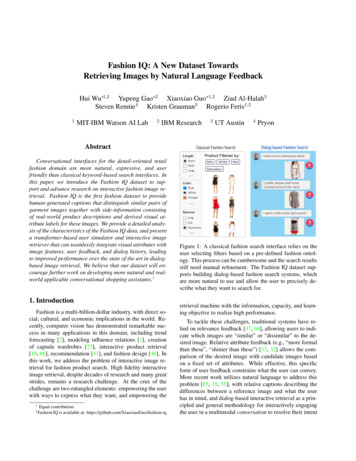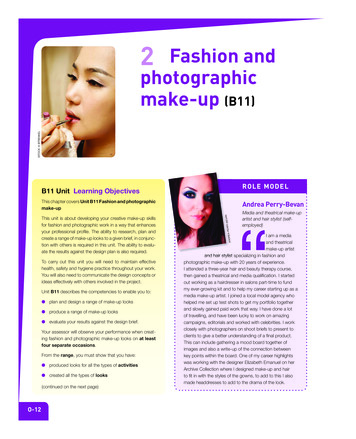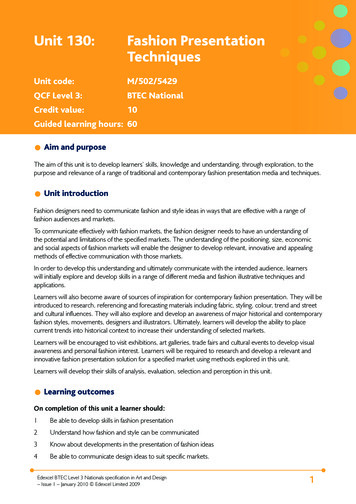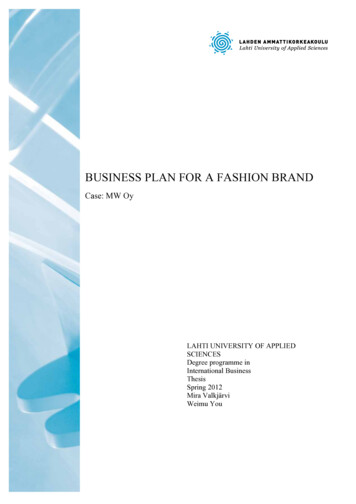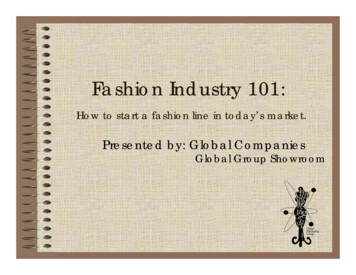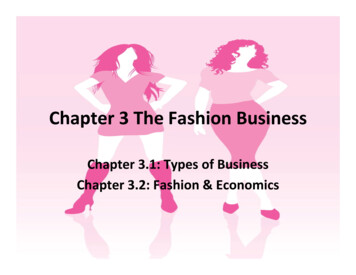
Transcription
Chapter 3 The Fashion BusinessChapter 3.1: Types of BusinessChapter 3.2: Fashion & Economics
Key Terms Primary Market Secondary Market Tertiary Market Retailing Sole Proprietorship Partnership Corporation Risk Risk Management
Fashion Businesses AA series of events takeplace for a business tohave a fashion productthat consumers willaccept and buy
Fashion Industry Segments The primary market is the industry segment that includesbusinesses that grow and produce the raw materials thatbecome fashion apparel or accessories The secondary market is the industry segment thatincludes businesses that transform raw materials intofashion in the merchandise production phase The tertiary market is the industry segment that includesretail businesses such as stores
Primary Market ThisThis phase involves technicalresearch and planning TheThe textile industry is thelargest segment of theprimary market TextilesTextiles is a broad termreferring to any material thatcan be made into fabric byany methodCottonSilk
Secondary Market BusinessesBusinesses in this market produce garments bytransforming textiles to the finished product, orwearing apparel ProducersProducers are responsible for designing,producing, and selling the goods to retailers TheThe main types of producers in the secondarymarket include: ManufacturersManufacturers WholesalersWholesalers ContractorsContractors ProductProduct Development Teams
Secondary Market ManufacturersManufacturers:Manufacturers: handle all operations such asbuying the fabric, designing or buying designs,making garments, and selling and delivering thefinished garments WholesalersWholesalers:Wholesalers: Have a design staff who produces thedesigns. They also coordinate the selling anddelivery processes
Secondary Market Contractors: may be responsible formany aspects of productionproduction- fromsewing and sometimes cutting to thedelivery of goods. May include the production of aprivate label,label, which is the store’store’s label Product Development Teams:Teams: theseteams design, merchandise, andoutsource work to contractors in theU.S. or outside the countryXhilaration forTarget
Tertiary Market Retailing is the selling of products to customers Selling can either be direct selling or the exchange ofmerchandise in return for money or credit Types of retail stores include: DepartmentDepartment stores SpecialtySpecialty stores DiscountDiscount department stores VarietyVariety stores OffOffOff-price stores WarehouseWarehouse stores OutletOutlet stores NonNonNon-store retailers
Support Industries TheseThese are businesses that helpwith all other businessfunctions ExamplesExamples include: AdvertisingAdvertising Firms AccountingAccounting & FinancialCompanies ProductProduct Development MarketMarket Research
Types of Fashion BusinessOrganization TheThe fashion industry and other industriesare comprised of businesses that have one ofthe three common types of businessorganization: ProprietorshipProprietorship PartnershipPartnership CorporationCorporation
Sole Proprietorship A sole proprietorship is a businessowned and operated by one person Risk TheThe owner takes responsibility forall assets owned; personally liablefor the company Taxes TaxedTaxed as personal income tax at arate less than the rate imposed oncorporations Pros and Cons OwnerOwner has the freedom to operate ashe or she feel necessary
Partnership A partnership is a business createdthrough a legal agreement between 2 ormore people who are jointly responsiblefor the success or failure of the business Taxes EachEach partner is taxed separately onindividual tax returns; must file anannual information return to reportincome Personal Liability EachEach partner is personally liable fordebts of the partnershipMiley Cyrus & Max Azria
Corporation A corporation is a business that ischartered by a state and legally operatesapart from the owner or owners Stocks & Shareholders CorporationsCorporations are traded on the stockexchange, ownership is divided intoshares of stock Taxes ProfitProfit if a corporation is taxed to boththe corporation and the shareholderswhen the profit is distributed asdividends
Fashion Risks Risk is the possibility that a loss can occur as theresult of a business decision or activity For designers, there is risk that someone will copytheir designs and produce apparel faster or lessexpensively
Risk Management RiskRisk management is a strategy to offset businessrisk RiskRisk management is a systematic process ifmanaging an organization’organization’s risk exposure toachieve objectives in a manner consistent withpublic interest, human safety, environmentalfactors, and the law
Types of Risk Economic Risk ChangesChanges in the overallbusiness conditions Human Risk CausedCaused by human mistakesas well as by theunpredictability of customers,employers, or the workenvironment Natural Risk NaturalNatural causes such as theweather
Other Categories of Risk PurePure Risk RisksRisks that occur when there is a possibility of aloss, but no chance to gain from the event SpeculativeSpeculative Risk RisksRisks that occur when gains and losses arepossible ControllableControllable Risk RisksRisks that can be prevented or reduced infrequency
Other Categories of Risk UncontrollableUncontrollable Risk EventsEvents that a fashion business cannot preventfrom occurring, such as the weather InsurableInsurable Risk PurePure risk that could exist for a large number ofbusinesses UninsurableUninsurable Risk RisksRisks that occur when the chances of riskcannot be predicted or when the amount of losscannot be estimated
Managing Potential Risk Businesses can handle risk by different methods: PurchasingPurchasing insurance if necessary PreventionPrevention methods like employee training TransferringTransferring risk back to the manufacturer throughwarranties
Chapter 3.2: Fashion &Economics
Key Terms GlobalizationGlobalization ImportsImports ExportsExports BalanceBalance of Trade SupplySupply DemandDemand ProfitProfit TradeTrade Quotas
Impact on Global Economy ForFor centuries, ships have carried goods fromexotic ports of call ChangesChanges in government policies and newtrends in international trade have caused themarket for fashion goods to increase
Globalization and Fashion GlobalizationGlobalization is theincreasing integration of theworld economy ImprovedImproved worldwidecommunication systems,such as the internet, and theease of world travel haveopened the doors to othercountries
Global Competition This globalization has created competition betweencountries in the manufacturing sector of fashion Labor is a major component of the cost of production forfashion products Many foreign governments offer incentives, such asfavored status and tax exemptions
The Balance of Trade Imports are goods that come into a country from foreignsources or goods that a country buys from other countries Exports are goods that a country sends to a foreign source orgoods that a country sells to other countries The balance of trade is the relationship between a country’country’simports and exports, and it affects the economic health of acountry
Trade Agreements & Restrictions The North American Free TradeAgreement (NAFTA) is between the U.S.,Mexico, and Canada TheThe goal is to enable all countries toexperience free trade by eliminatingor reducing tariffs, or fees, fortrading goods The World Trade Organization (WTO)is an international organization thatpromotes and enforces trade laws andregulations 145145 countries ReduceReduce barriers to trade
Globalization & America GlobalizationGlobalization in fashion is evident FifthFifth Avenue GivenchyGivenchy EscadaEscada BenettonBenetton GapGap
International Fashions The fashion business is trulyinternational, as producers,designers, and retail buyers cover theglobe in search of new products andideas ProducedProduced in China with fabricfrom India and buttons from Bali DesignedDesigned by a designer in France ModeledModeled in Milan PurchasedPurchased in New York City
Impact on Domestic Economy U.S. consumers spend 275 billion everyyear on apparel IncludesIncludes 3 billion slacks or pants 5.75.7 billion shirts and blouses 370370 million sweaters Americans spent 320 billion on homefurnishings IncludesIncludes 560 million sheets andpillowcases 1.81.8 million towels and washcloths
Textile Industry Impact TheThe textile industry includes textile mills,textile producers, apparel, fibers, andmachinery TheseThese industries support 2.75 million jobs
Textile Industry Issues IssuesIssues surrounding the textile industry havedramatic impact on the economy BecauseBecause of the rise in competition, the U.S.textile and apparel industries have becomemore competitive
Supply & Demand SupplySupply is the quantity ofproduct offered for sale at allpossible prices DemandDemand is the consumer’consumer’swillingness and ability tobuy and/or use producers TheThe interaction betweensupply and demand createsthe conditions of surplus,shortage, or equilibrium
Supply & Demand
Profit ProfitProfit is the money a business makes afterall costs and expenses are paid ProfitProfit dictates the supply of goods availablefor sale OtherOther factors that influence supply: GovernmentalGovernmental laws and regulations SubsidiesSubsidies BadBad publicity BoycottsBoycotts PromotionPromotion and advertising
Employment in the Fashion Industry TheThe most obvious impact the fashionindustry has on the economy is in the areaof employment TradeTrade quotas are restrictions on the quantityof a particular good or service that a countryis allowed to sell or trade
Global Employment SkilledSkilled labor tends to stay in the U.S. ManuelManuel labor tends to be outsourced TheThe textile and apparel industries willcontinue to be a major provider of a variety ofjobs as the fashion business continues togrow
THE END
fashion in the merchandise production phase The The tertiary market tertiary market is the industry segment that includes retail businesses such as stores. . Producers are responsible for designing, producing, and selling the goods to retailers The main types of producers i

